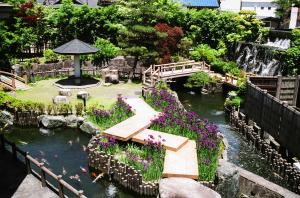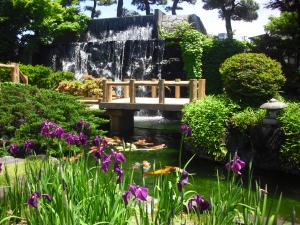Nishikigoi
Nishikigoi
Vibrant nishikigoi carp are considered living works of art for their variety of colors and patterns. These ornamental carp originated in Ojiya, from a serendipitous genetic mutation in black carp. Selective breeding since the 1800s has resulted in over 100 varieties, many of which are exported around the world. Prices depend on the patterning and the size of the fish, but a rare nishikigoi can cost as much as a house, fetching up to one million U.S. dollars.
A chance mutation
Farmers in Ojiya have bred ornamental carp since the 1800s. They derive from black carp (Cyprinus carpio), in which chance genetic mutations gave rise to red patterns on the carp’s scales. Farmers in the Higashiyama district of Ojiya continue to systematically breed the carp to produce large ornamental varieties.
Nishikigoi gain national recognition
Keeping rare breeds of ornamental carp was historically a pastime reserved for court nobles in the Heian period (794–1185). It remained an exclusive pastime of the nobility until well into the Edo period (1603–1867). After nishikigoi breeding developed in the 1800s, ornamental carp became more readily accessible to anyone with the means. Nishikigoi came to national attention in 1914 at the Tokyo Taisho Exhibition, an event that showcased Japan’s latest products and technologies. From then on, interest spread throughout the country, and the pastime boomed. Ornamental carp breeding became particularly popular in the 1960s, when Japan’s economy was growing rapidly.
Nurtured by snow and soil
The environment in Ojiya is ideal for raising and nurturing strong, healthy carp, with a life expectancy of around 30–40 years. Abundant snowmelt provides pristine, mineral-rich water for raising the fish in terraced hillside ponds. Over the centuries, koi farmers have observed that some types are better suited to sandy soil ponds, whereas others thrive in mineral-rich clay ponds.
Types of nishikigoi
The many varieties of nishikigoi are distinguished by their colors, patterns, and scales. The three most popular varieties are Kohaku, Taisho Sanshoku, and Showa Sanshoku, collectively known as the Gosanke (“The Big Three”).
Kohaku is a white-scaled carp with splashes of red. It was one of the first ornamental koi varieties to be bred in Ojiya in the 1800s. Taisho Sanshoku emerged during the Taisho era (1912–1926) and resembles the Kohaku, accentuated with black specks. The Showa Sanshoku has the same three colors as the Taisho Sanshoku, but in general black is the predominant color. They were first bred during the Showa era (1945–1989).
Other popular varieties include the metallic gold Ogon and the light blue Asagi. Many are given evocative names like Utsurimono (reflection), Kumonryu (nine-tattooed dragon), and Kujaku (peacock).
Prized traits
Koi are prized for a variety of traits, including body shape, size, color, shine, pattern, and how gracefully they swim in water. The shape of their body is considered most important. The ideal nishikigoi has a spindle-shaped body with well-developed muscles along the spine. Carp that have all of these traits can sell for over ¥100 million (around $1 million).
Nishikigoi Breeding, Hobbyists, and Shows
Nishikigoi carp have been bred in Ojiya since the 1800s and are an important part of the town’s heritage. Koi farms and breeding techniques have been passed down for generations. Auctions take place from autumn to spring, drawing koi collectors from around the world. Breeders from all over Japan gather at annual nishikigoi shows, entering their most beautiful specimens for the chance to be declared “Grand Champion.”
Breeding nishikigoi
A large number of Japan’s nishikigoi breeders are based in the mountainous areas around Ojiya, where they raise the fish in terraced ponds. Throughout the spawning season, which lasts between April and early July, breeders carefully select koi to mate. Lineage and physical traits, such as brightness of color and body shape are among the factors that influence the matchmaking process. Once the fry are born, those with the most vivid and distinct patterns are selected and raised at the farm for eventual sale.
Water and soil quality play a vital role in raising healthy koi. The abundant snowmelt from the mountains around Ojiya supplies the ponds with fresh, clean groundwater, rich in minerals. Years of experience and observation have led farmers in the region to conclude that the type of soil in which ponds are dug plays a role in the healthy development of different varieties of koi. For instance, breeders believe that the multicolored Showa Sanshoku variety is suited to ponds dug in sandy soil, and that the red-and-white Kohaku thrives in clay-rich soil.
Koi reach a suitable size for sale in September the year they are born, and reach adulthood after two to four years. Auctions take place from autumn to spring in Ojiya and other nishikigoi hubs around Japan, such as Aichi and Hiroshima prefectures.
Ojiya’s nishikigoi fishery cooperative is made up of about 60 breeders, and the majority of the koi they raise are exported overseas.
Keeping nishikigoi as a hobby
In the 1960s, keeping nishikigoi gained widespread popularity in Japan, and began to be admired overseas. The development of modern shipping technology has made it easier to safely ship the carp over long distances, and the number of nishikigoi hobbyists around the world continues to grow. Koi adapt well to a variety of environments and can live for 30 to 40 years.
Showcasing Japan’s living jewels
Nishikigoi shows have been held annually around Japan from as early as 1912. These shows are an opportunity for breeders to showcase their most exceptional carp. The shows bring together koi enthusiasts and breeders from all over the world, during which the entries are appraised for their colors, shine, patterns, and numerous other traits. The shape of their body is particularly important—prize-winning nishikigoi tend to have spindle-shaped bodies with well-developed muscles along the spine.
The All Japan Nishikigoi Show, usually held in Tokyo, is considered one of the most prestigious. At the inaugural show in 1968, nishikigoi were dubbed Japan’s national fish. Since then, the show has been held annually in January, typically featuring over 4,000 fish. Other notable shows include the Zen Nippon Airinkai, held in November (the venue changes every year), and the All Japan Junior Koi Show, held in Niigata in April
Nishikigoi no Sato (Nishikigoi Village)
Learn about the history and the life cycle of koi, from small fry to large meter-long adults, at Nishikigoi no Sato (Nishikigoi Village), in central Ojiya. Exhibits detail the black carp’s evolution into the colorful nishikigoi so sought-after today. Visitors can see hundreds of healthy carp in aquariums, viewing pools, and Japanese garden ponds where koi swim along channels and under bridges. Stroll the traditional gardens to observe the colorful koi up close and even feed these “living jewels.”
Discover and learn
In Nishikigoi no Sato’s main viewing hall, visitors can learn about the many varieties of nishikigoi, including the traditional types—white with splotches of red, orange, and black—as well as the more recently bred gold and platinum varieties.
Displays depict the history of koi and the genetic mutation that led to the emergence of these colorful varieties from black carp. Multilingual panels and photos illustrate how the koi are raised, and explain their significance in Japanese culture. A video with English narration about the koi life cycle, breeding, and the world of koi hobbyists, is available to watch upon request in the viewing area.
Observe and interact
An indoor viewing pool houses around 100–350 large adult koi, which can be observed from all angles. Young fry swim in small fish tanks surrounding the pool. Outside the building, koi swim gracefully in ponds and along channels in a Japanese garden featuring seasonal flora, miniature waterfalls, and traditional bridges. Visitors may purchase food for feeding the fish in the garden ponds. From late November to March, the koi are brought indoors to protect them from the cold. About 20 different varieties are kept on the premises.
Nishikigoi ownership system
Many of the 300 or so koi kept at Nishikigoi no Sato have private owners. At the entrance of Nishikigoi no Sato there are rows of photos of nishikigoi with the names of their owners written next to them.
Nishikigoi No Sato Information
1-8-22 Jonai, Ojiya City
Hours: 9:00a.m.-6:00p.m. *Until 5:00p.m.between December and February
Admission: Adult/520yen Elementary and Junior high students/310yen



※This English-language text was created by the Japan Tourism Agency.
















